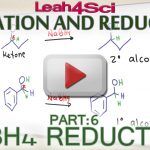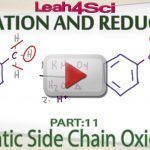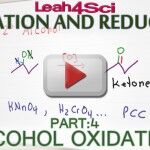Oxidation and Reduction reactions will come up over and over in your organic chemistry course. Think you’ve mastered redox reactions and reagents? Try the practice quiz below then scroll down (end of the quiz) for the PDF solutions. Not fully confident with redox? Review the redox tutorial video series and follow along with the Orgo Redox […]
Sodium Borohydride Carbonyl Reduction Reaction and Mechanism
Sodium Borohydride NaBH4 is a common reducing reagent used with carbonyl compounds. NaBH4 is a weak reducing agent and will only reduce ketones and aldehyes. Watch for the explanation below including reaction, mechanism, and practice problems. (Watch on YouTube: NaBH4 Reduction. Click cc on the bottom right for video transcript) <–Watch Previous Video: Alcohol Oxidation Mechanism H2CrO4 […]
Aromatic Side Chain Oxidation to Carboxylic Acid
Aromatic side chain oxidation is an interesting reaction. Benzene is not easily oxidized, nor is an alkane. However, when attached to a benzene ring the benzylic carbon is susceptible to a unique oxidation yielding a benzoic acid. This video walks you through the reaction including what to look out for along with multiple practice problems. […]
Lithium Aluminum Hydride LiAlH4 Carbonyl Reduction Reaction and Mechanism
Lithium Aluminum Hydride LiAlH4 is the stronger ‘common’ carbonyl reducing agent. In addition to reducing aldehydes and ketones like NaBH4, LiAlH4 will also reduce carboxylic acids and carboxyl derivatives. The video below shows you a molecule and reaction overview followed by the reduction mechanisms for LiAlH4 with various carbonyl compounds. (Watch on YouTube: LiAlH4 Reduction. Click […]
Alcohol Oxidation Mechanism H2CrO4 PCC KMnO4
Oxidation of alcohols can be carried out by a variety of reagents. The most common mechanisms you’ll study in your organic chemistry course involve Chromic Acid H2CrO4, Pyridinium Chlorochromate PCC, and Potassium Permanganate KMnO4. The video below shows you how each of these mechanisms will react with primary alcohols to form an aldehyde or carboxylic […]
Oxidation of Alcohols to Aldehyde Ketone and Carboxylic Acid
Alcohols can be oxidized to aldehydes, ketones and carboxylic acids. The specific product will be determined by the substitution of the starting alcohol, and the specific oxidizing reagent used in the reaction. This video will show you how to identify the oxidation products (or lack of) for primary, secondary and tertiary alcohols. We’ll look at the […]
Birch Reduction Reaction and Mechanism
Aromatic compounds are considered very stable thus difficult to react. Birch Reduction is one example of an extreme reaction strong enough to break benzene’s aromaticity to form an non conjugated cyclohexadiene. This video breaks down the reaction and mechanism, followed by my trick for quickly identifying the product when EDG/EWG substituents are present. (Watch on YouTube: Birch […]
Oxidation and Reduction of Alkenes and Alkynes
This video takes you through the various oxidation and reduction reactions you’ve covered back in alkene and alkyne reactions. In this video we differentiate between redox reactions vs reactions that add oxygen/hydrogen without a net reduction. This video also compares different types of oxidative cleavage reactions using Ozonolysis and KMnO4 for terminal and internal alkenes […]
Introduction to Oxidation Reduction Reactions in Organic Chemistry
Oxidation and Reduction reactions in organic chemistry are very different than the redox concepts covered in general chemistry. This video shows you how the same gen-chem concepts apply, while helping you analyze it from a molecular and organic chemistry reaction perspective. This video covers the logic, definitions, and tricks to look out for when identifying […]
Tollens Reagent Silver Mirror Test for Aldehydes
The Tollens Test for Aldehydes, also known as the Silver Mirror Test, is a great way to confirm if an unknown carbonyl is an aldehyde or not. This occurs by reacting the unknown carbonyl with Silver +1 which gets reduced to metallic silver (Ag 0) when the aldehyde is oxidized to a carboxylic acid. This […]












